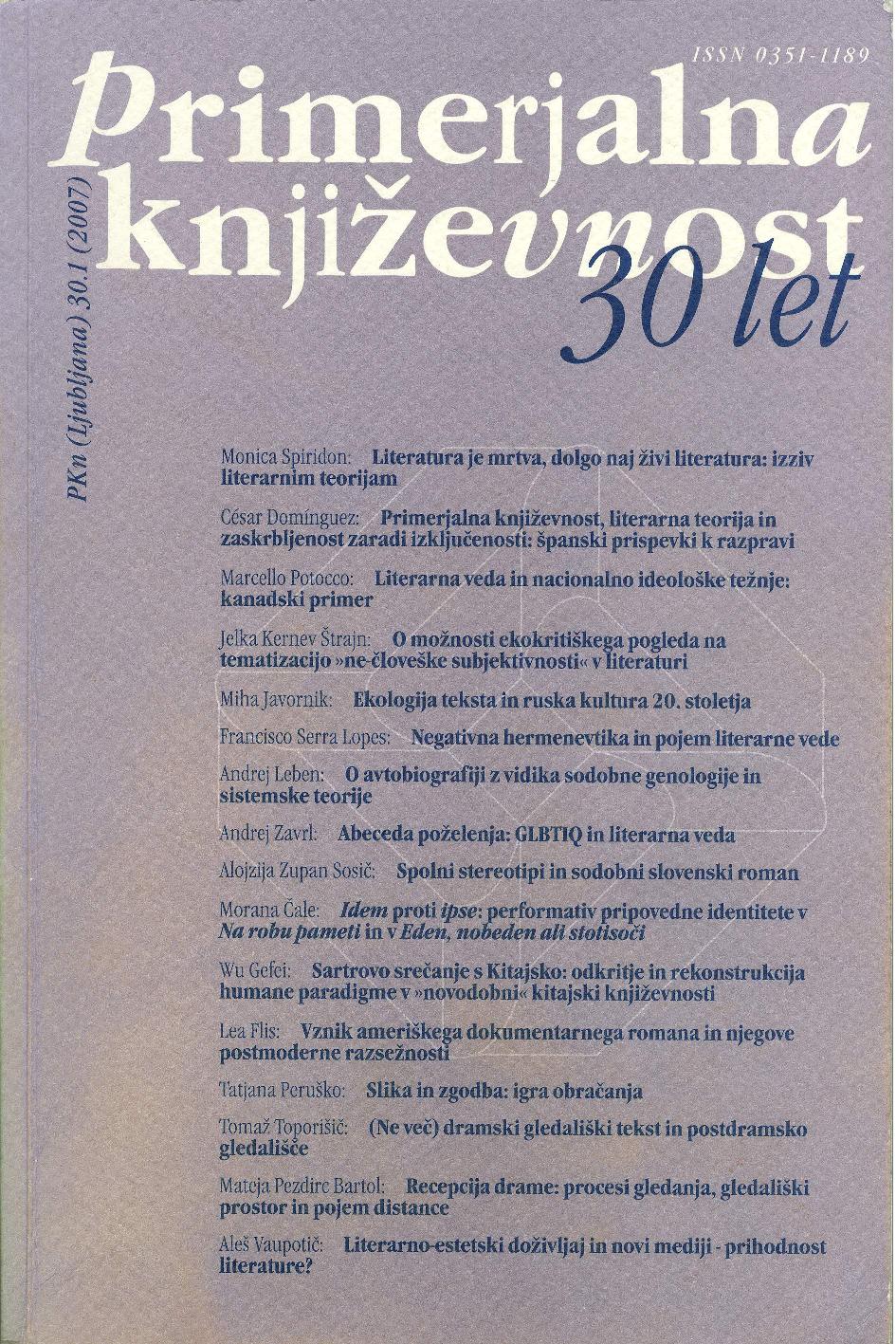The Reception of Drama: Viewing Processes, Theatrical Space, and the Concept of Distance
Keywords:
theory of drama, postmodern theatre, stage techniques, audience, Slovene theatre, Pograjc, MatjažAbstract
The double existential status of drama (literary text and theater performance) requires various types of recipients. There are three different types of drama recipient: the readers of the dramatic text, the director and actors (or the entire theater crew), and the audience watching the performance. The audience as an element of theater communication has become the subject of interest of various disciplines in the multimedia civilization. Among the first of these disciplines was film studies. Due to certain receptive similarities, this provided a great deal of impetus for theater studies. This article analyzes how the issue of watching and the place and role of the audience in the performance has changed through history. The main factors in this were the electrification of theaters, the appearance of professional directors at the end of the 19th century, and the efforts of theater reformers at the beginning of the 20th century. These reformers wanted to rouse the audience out of their numbness and indifference, and so they sought various alternative spatial arrangements to shatter the optical box of the Italian stage and break the traditional view of the audience. On the other hand, they wanted to demolish the basic theater convention most frequently referred to as distance. According to Erika Fischer Lichte, postmodern theater differs somewhat from its avant-garde predecessors, whose goal was to bring art close to life, shock the audience, make them fall into a trance and daze, and transform them into new beings. Postmodern theater does not share these same goals, but offers the freedom of randomly ascribing meaning back to the audience. By using the concrete example of Matjaž Pograjc’s direction of Fragile! by Tena Štivičić, this article demonstrates how modern direction combines theater with new media and thus poses questions for the audience about the way they watch, and at the same time plays with the concept of distance because it alternately uses the principles of inclusion and separation. As a result, such performances demand a view of the audience that is active, creative, and free – but, because of this, uncertain in its basic operation as well.References
Artaud, Antonin. Gledališče in njegov dvojnik. Ljubljana: Mestno gledališče ljubljansko, 1994. (zv. 119).
Balme, Christopher B. »Prizorišče vida: Podoba, telo in medij v sodobnem gledališču.« Maska 18.2–3 (2003): 37–41.
Batušić, Nikola. Uvod u teatrologiju. Zagreb: Grafički zavod Hrvatske, 1991.
Bauchard, Franck. »Gledališče kot aparat za gledanje.« Maska 18.2–3 (2003): 25–28.
Ben Chaim, Daphna. Distance in the Theatre: The Aesthetic of Audience Response. Ann Arbor, Michigan: UMI Research Press, 1981.
Bennet, Susan. Theatre Audiences. A Theory of Production and Reception. New York: Routledge, 2001.
Brecht, Bertolt. Umetnikova pot. Ljubljana: CZ, 1987.
Chaudhuri, Una. »The Spectator in Drama/Drama in the Spectator.« Modern Drama 17.3 (1984): 281–297.
De Marinis, Marco. »Dramaturgija gledalca.« Prisotnost, predstavljanje, teatralnost. Ur. Emil Hrvatin. Ljubljana: Maska, 1996. 189–204.
Fischer Lichte, Erika. The Show and the Gaze of Theatre: A European Perspective. Iowa City: University of Iowa Press, 1997.
Inkret, Andrej. Drama in gledališče. Ljubljana: DZS, 1986. (Literarni leksikon 29).
Kindermann, Heinz. »Pozorišna publika antike.« Scena 26.5 (1990): 4–12.
Kralj, Lado. »Drama in prostor.« Primerjalna književnost 21.2 (1998): 75–96.
– – –. Teorija drame. Ljubljana: DZS, 1998. (Literarni leksikon 44).
Lehmann, Hans Thies. Postdramsko gledališče. Ljubljana: Maska, 2003.
Lennard, John in Mary Luckhurst. The Drama Handbook. A Guide to Reading Plays. Oxford, New York: Oxford University Press, 2002.
Lukan, Blaž. »Dom v srcu.« Delo, 29. 12. 2005. 9.
– – –. »Uvod v Artauda.« Artaud, Antonin. 6–3.
Mcauley, Gay. Space in Performance: Making Meaning in the Theatre. Ann Arbor, Michigan: The University of Michigan Press, 1999.
Rokem, Freddie. »Kako gledamo? Konstrukcije gledalca v sodobnem gledališču.« Maska 18.2–3 (2003): 7–10.
Szondi, Peter. Teorija sodobne drame 1880–1950. Ljubljana: Mestno gledališče ljubljansko, 2000. (zv. 130).
Ubersfeld, Anne. »Gledalčev užitek.« Prisotnost, predstavljanje, teatralnost. Ur. Emil Hrvatin. Ljubljana: Maska, 1996. 205–218.


